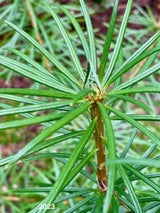- Plant IDs
- >
- ID By Type
- >
- Trees
- >
- Evergreen Trees
- >
- Conifers
- >
- Cathaya argyrophylla
Cathaya argyrophylla
Common name: Yin Shan, Cathay silver fir
Cathaya argyrophylla: The dawn redwood has another tree in our garden from its own era. C.argyrophylla is a living fossil in the pine family. Cathay silver fir is the only species in its genus but does share certain similarities with pines, Douglas firs, and spruces. It was planted in 2010 in bed 74. Now this rare conifer only grows in a limited area in southern China on steep, narrow mountain slopes with limestone soils. Before its scientific discovery and protection in 1950, a larger population had been reduced by over-cutting.
Today (unlike the dawn redwood) little is known about this tree as China’s borders tightened soon after its discovery. It took many years before visits into the reserves and seed collecting were allowed. In China, Cathay silver fir grows to 20 meters and its green needles have silvery white backs. And nobody knows how tall this tree will grow outside of China. More about this.
2020: The tree was donated by volunteer Dick McKenzie in 2010 but kept in the nursery. On a walk in August 2015, the gardener showed us the newly-planted C. argyrophylla that had become potbound (hence the yellow needles). [Five years on it still had yellow needles.] This specimen probably lost its leader, which is why it is so bushy. It grows to 20 metres/65 feet in the wild, but the gardener doesn't think our plant will grow that high.
2023 Update: I have been watching Cathay silver-fir since taking the yellow-needled photos in 2020. I was hoping the yellow needles would change to green and the tree would show signs of growing. But nothing changed. It seemed to be frozen in time. Then in fall 2023 not only had all of its yellow needles turned green, but also it had made a growth spurt and acquired a leader. And this happened in a very short time. Maybe it liked the fall rains that followed our hot summer. Or maybe it was just ready to grow for no particular reason. It has some company as our Emmenopterys henryi flowered for the first time in 2023. The green-needled pictures were taken in October 2023
Text and photos by Hughie Jones. Undated photos (with yellow needles) taken in 2020.








